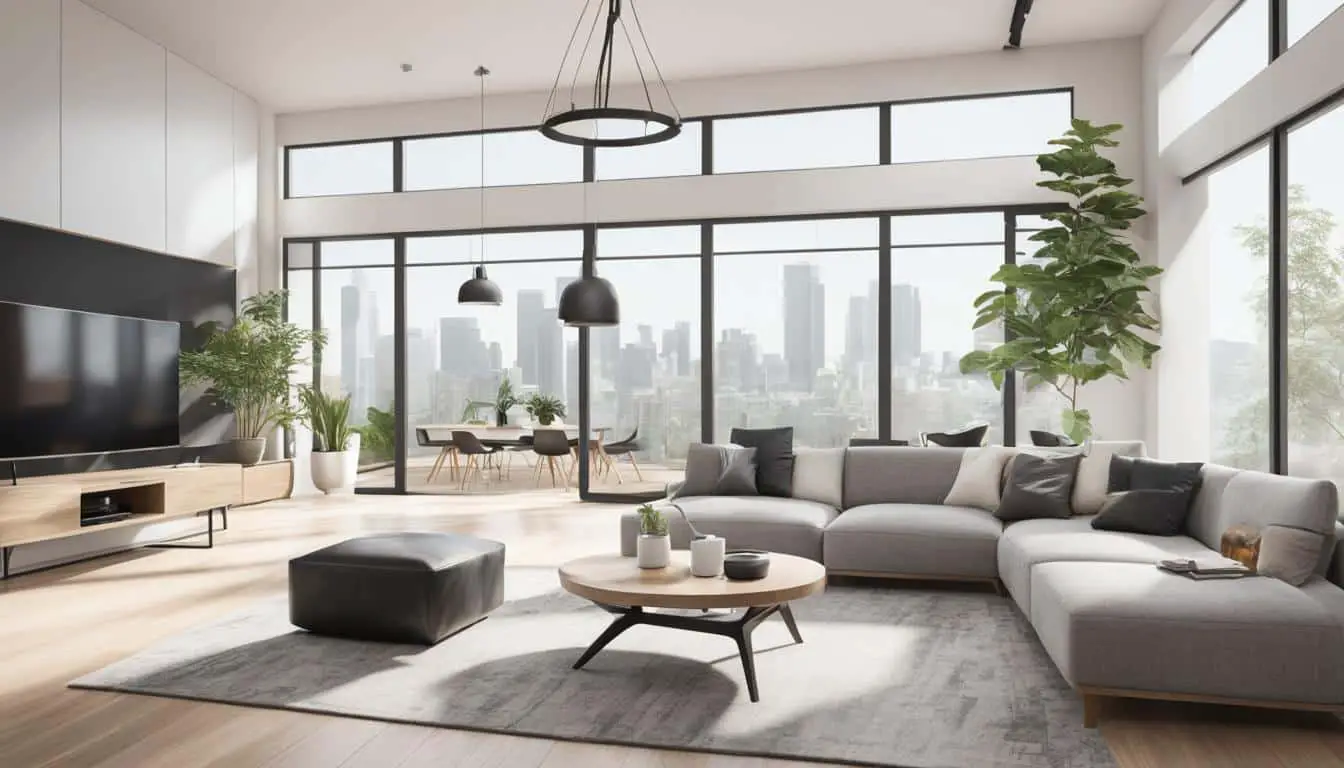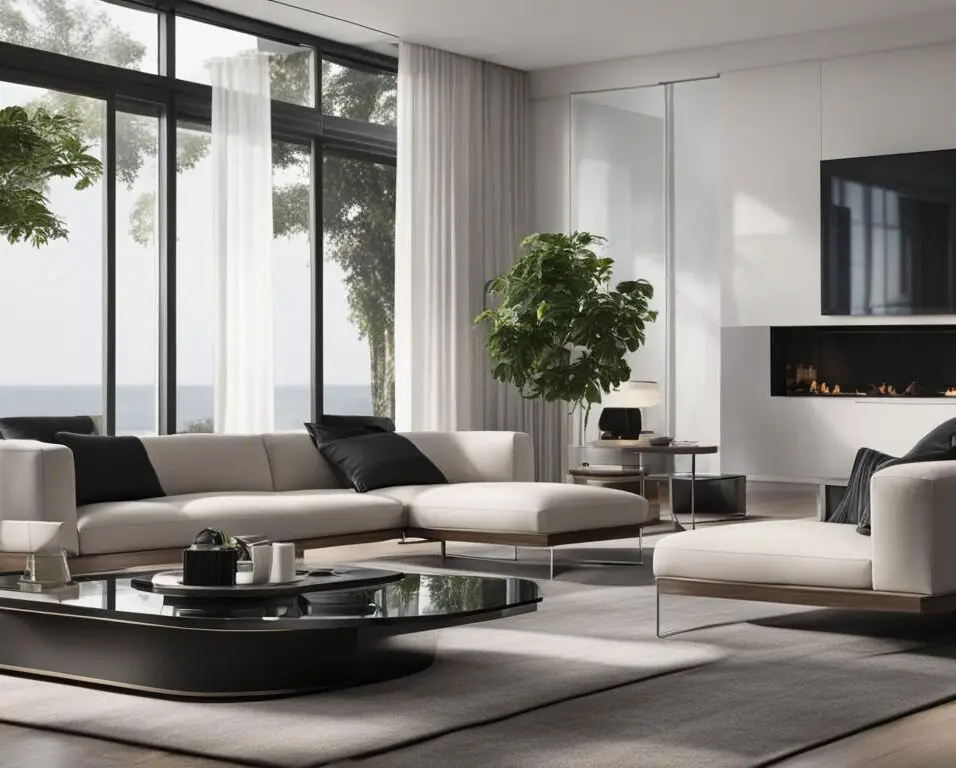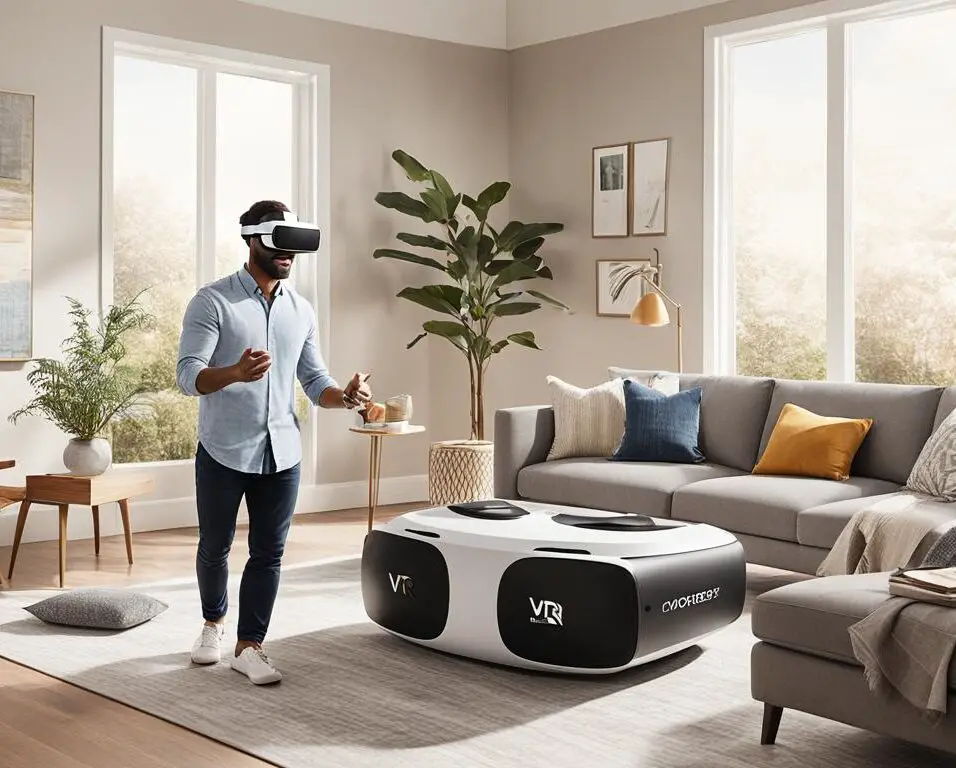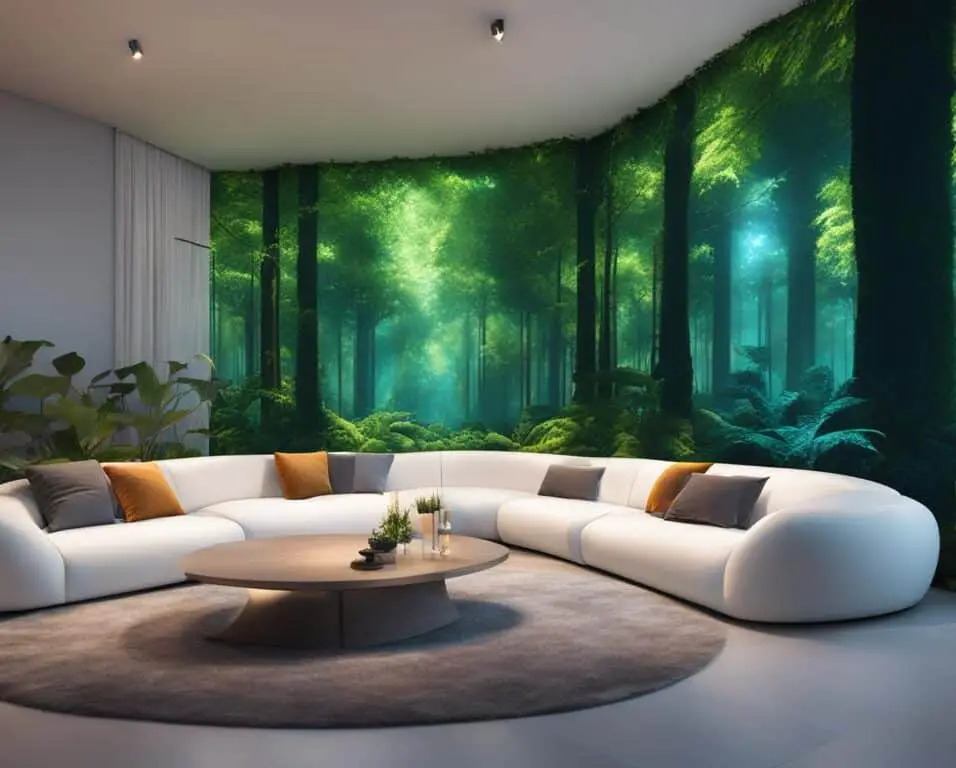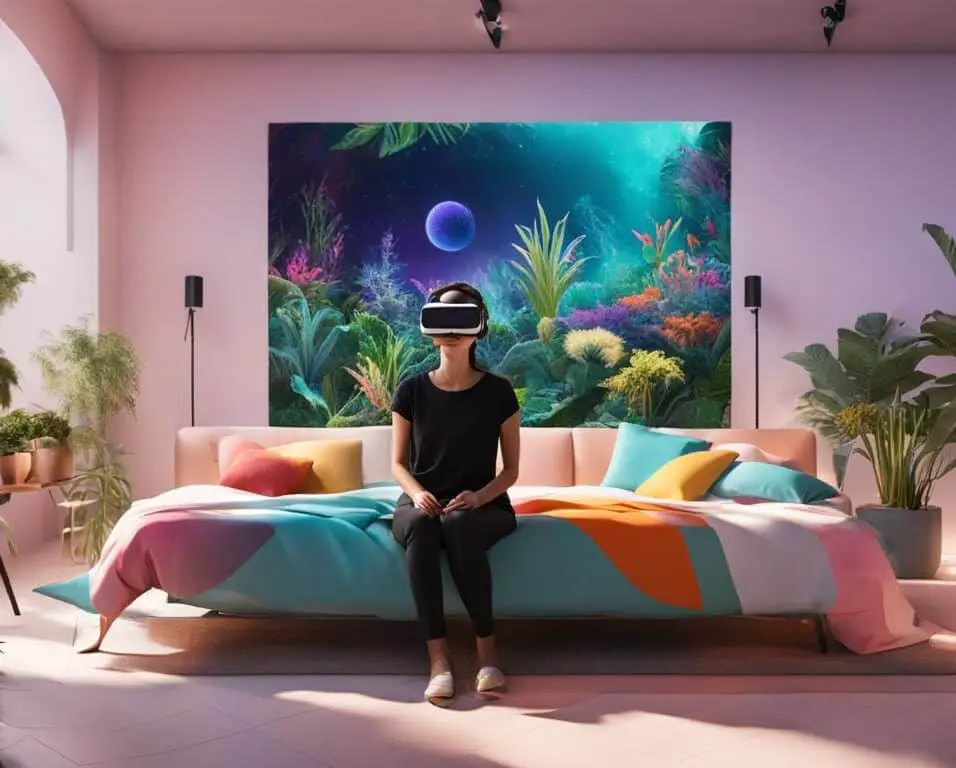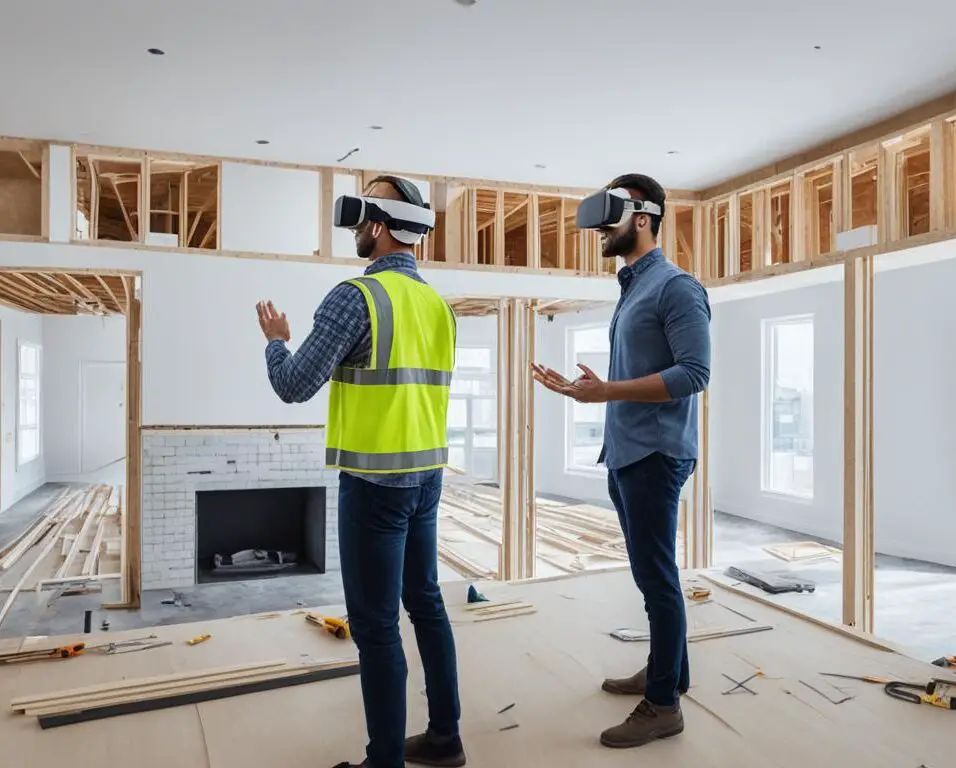Urban Oasis: Virtual Reality in Modern City Home Design
As a journalist specializing in architecture and design, I have witnessed how virtual reality technology is revolutionizing the world of urban home design in modern cities. The use of virtual reality in this field has opened up endless possibilities for architects and designers to create immersive spaces that cater to the needs and preferences of those living in modern cities. In this article, we will explore the impact of virtual reality on urban home design and how it is transforming traditional living spaces into efficient and visually stunning urban oases that enhance the quality of life for residents.
Key Takeaways:
- Virtual reality technology is revolutionizing urban home design in modern cities.
- Architects and designers can create immersive and efficient spaces with virtual reality.
- Virtual reality enhances the home buying experience with virtual tours and realistic renderings.
- Homeowners can customize and personalize their urban homes using virtual reality.
- Virtual reality enables the integration of energy efficiency and sustainability into urban home designs.
Redefining Space with Virtual Reality
Virtual reality technology has opened up new possibilities for architects and designers to redefine space in urban home design. By leveraging the power of virtual reality simulations, professionals can push the boundaries of traditional design concepts and create innovative spaces that optimize layouts for optimal functionality and visual appeal.
Through virtual reality technology, architects and designers have the ability to visualize and experiment with various spatial configurations, furniture placements, and interior designs. This immersive experience allows them to iterate quickly and efficiently, exploring different possibilities to achieve the most innovative and effective urban home designs.
One of the key advantages of virtual reality in redefining space is the ability to optimize layouts. Designers can experiment with different furniture arrangements and see how these arrangements impact the flow of space and the overall aesthetic. This allows for the creation of optimal layouts that maximize usable space and create an environment that meets the unique needs and preferences of the homeowners.
Furthermore, virtual reality simulations enable architects and designers to fine-tune details that contribute to the overall functionality and visual appeal of urban homes. This includes considerations such as lighting, color schemes, materials, and finishes. By exploring these elements in a virtual environment, they can make informed decisions that result in spaces that are not only functional but also visually stunning.
Benefits of Redefining Space with Virtual Reality:
- Ability to visualize and experiment with different spatial configurations
- Optimize layouts for optimal functionality and appeal
- Create innovative designs that push the boundaries of conventional space
- Fine-tune details to enhance the overall experience in urban homes
Virtual reality technology truly redefines space in urban home design by empowering architects and designers to think outside the box and create spaces that are both innovative and functional. As this technology continues to advance, the possibilities for reimagining and optimizing space in urban homes will only continue to grow.
| Key Features | Benefits |
|---|---|
| Innovative Designs | Pushes the boundaries of conventional space and creates truly unique living environments |
| Optimal Layouts | Maximizes functionality and usability of urban homes by strategically arranging furniture and optimizing flow |
| Efficient Decision-making | Enables quick iteration and exploration of design possibilities, leading to more informed decisions |
| Enhanced Visualization | Provides a realistic and immersive environment for architects, designers, and homeowners to visualize and experience future living spaces |
With virtual reality, architects and designers have the tools to redefine space in urban home design, unlocking the potential for truly transformative and immersive living environments.
Enhancing the Home Buying Experience
Virtual reality technology is revolutionizing the home buying experience by offering potential buyers a whole new level of engagement and interaction. With virtual tours, interactive viewing options, and realistic renderings, prospective buyers can explore and experience urban homes without physically visiting the properties. This enhances the home buying experience by providing a realistic sense of the space and helping buyers make more informed decisions.
Virtual tours allow buyers to virtually step inside a property, providing a comprehensive view of the layout, finishes, and overall ambiance. By wearing a virtual reality headset, buyers can navigate through each room, examine details, and get a true sense of the property’s size and functionality. This immersive experience can be accessed from the comfort of their own homes, making it convenient and accessible.
Interactive viewing takes virtual tours a step further by allowing buyers to interact with virtual objects within the space. This means they can open doors, turn on lights, adjust furniture and decor, and truly envision how they would personalize the property to suit their own taste and lifestyle. Being able to virtually manipulate objects creates a sense of ownership and helps buyers envision themselves living in the space.
Virtual reality is transforming the home buying process by bridging the gap between imagination and reality. It allows potential buyers to explore and engage with properties in ways that were not possible before, ultimately helping them make more confident and informed decisions.
Realistic renderings add another dimension to the home buying experience by providing visually stunning representations of urban homes. These highly detailed and accurate renderings showcase the architecture, interior design, and overall aesthetic of the property. By experiencing the space through realistic renderings, buyers can visualize themselves living in the property and get a better understanding of its unique features and design elements.
Overall, virtual reality technology is revolutionizing the way urban homes are bought and sold, taking the home buying experience to a whole new level. It offers potential buyers the opportunity to explore properties remotely, interact with virtual objects, and view realistic renderings, all of which enhance their understanding and connection to the property. By harnessing the power of virtual reality, both buyers and sellers can benefit from a more efficient, immersive, and informed home buying experience.
| Benefits of Virtual Reality in Home Buying | Enhanced Engagement and Interaction | Convenient and Accessible | Personalization and Visualization | Accurate and Detailed Representation |
|---|---|---|---|---|
| Virtual tours | ||||
| Interactive viewing | ||||
| Realistic renderings | 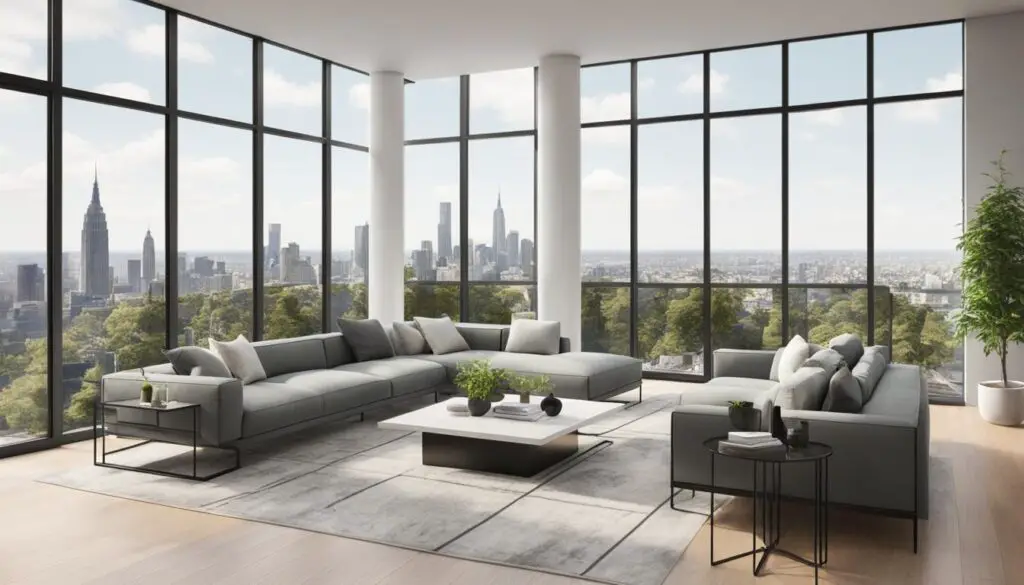 |
Customization and Personalization
When it comes to urban home design, customization and personalization are key factors in creating spaces that cater to individual preferences and tailored designs. Virtual reality technology offers homeowners the opportunity to bring their unique visions to life in a way that was once unimaginable.
With virtual reality, individuals can immerse themselves in a virtual environment, where they can experiment with different furniture arrangements, finishes, and decor options to create their ideal living spaces. By visualizing and virtually designing their urban homes, homeowners can ensure that every detail reflects their personal style and taste.
Imagine being able to try out different color schemes, test out various furniture arrangements, and explore different textures and materials, all from the comfort of your own home. Virtual reality makes it possible to see how different design choices will look and feel in a space before any physical changes are made, eliminating the need for costly and time-consuming trial and error.
The level of customization and personalization offered by virtual reality ensures that urban homes are truly tailored to the unique tastes and needs of each resident. Whether it’s a sleek and minimalist design or a cozy and eclectic atmosphere, virtual reality allows homeowners to bring their individual preferences to life in a way that is both efficient and visually stunning.
Virtual reality technology takes customization and personalization to a whole new level. With the ability to visualize and virtually experience different design choices, homeowners can make informed decisions that align with their specific tastes and preferences.
Creating Your Dream Space
With virtual reality, the process of creating your dream urban home becomes an immersive and interactive experience. Here’s how it works:
- Step 1: Define Your Vision – Start by envisioning your ideal living space. Consider the style, ambiance, and functionality you desire.
- Step 2: Experiment and Explore – Use virtual reality to experiment with different layout options, furniture styles, and color schemes to see what works best for your vision.
- Step 3: Customize to Perfection – Fine-tune every detail, from the finishes and materials to the lighting and decor, until your virtual space reflects your personal style.
- Step 4: Bring it to Life – Once you’ve perfected your virtual design, work with professionals to turn your virtual dream into a reality.
By utilizing virtual reality technology, homeowners can take control of the design process and create urban homes that are as unique as they are. The possibilities for customization and personalization are endless, allowing individuals to craft spaces that truly reflect their individuality.
| Benefits of Customization and Personalization in Urban Home Design | |
|---|---|
| 1. Reflects Personal Style | Virtual reality enables homeowners to select furniture, finishes, and decor options that align with their individual preferences, ensuring their urban homes reflect their personal style. |
| 2. Efficient Decision Making | With virtual reality, individuals can visualize and experience different design choices before making any physical changes, resulting in more efficient decision making. |
| 3. Tailored to Individual Needs | Virtual reality allows homeowners to customize their urban homes to meet their unique needs, ensuring that every aspect of the space is tailored to their individual preferences. |
| 4. Enhanced User Experience | By immersing themselves in a virtual environment, homeowners can experience their design choices firsthand, resulting in a more immersive and satisfying user experience. |
The ability to customize and personalize urban homes using virtual reality technology is a game-changer. It empowers homeowners to create spaces that are not only visually stunning but also functional and tailored to their specific needs. This level of customization ensures that urban homes truly become havens for individual expression and personalized living.
Energy Efficiency and Sustainability
Virtual reality technology not only revolutionizes the design process but also plays a crucial role in integrating energy efficiency and sustainability into urban home designs. By harnessing the power of virtual reality, architects and designers can visualize and simulate various energy-saving features, such as solar panels, green roofs, and smart home technologies, to create eco-friendly and energy-efficient homes. This innovative approach not only benefits the environment but also helps homeowners reduce their energy consumption and lower utility costs.
By immersing themselves in virtual reality environments, architects and designers can experiment with different design elements and evaluate their impact on energy efficiency. They can assess the effectiveness of different insulation materials, lighting systems, and HVAC strategies, allowing them to make informed decisions that maximize energy efficiency and minimize environmental impact.
Furthermore, virtual reality can simulate the performance of renewable energy systems, such as solar panels, by considering factors like sun orientation, shading, and energy storage capabilities. Architects and designers can optimize the placement and configuration of these systems to maximize energy generation and minimize reliance on traditional power sources.
Virtual reality also empowers homeowners to make sustainable choices when it comes to their urban homes. Through virtual reality experiences, homeowners can explore and select eco-friendly materials, appliances, and fixtures that promote sustainability and reduce their carbon footprint.
Advantages of Virtual Reality in Energy Efficiency and Sustainability
Virtual reality technology offers several advantages in integrating energy efficiency and sustainability into urban home designs:
- Visualization: Virtual reality enables architects and designers to visually experience and understand the environmental impact of design decisions, fostering a more conscious approach to sustainability.
- Simulation: Through virtual simulations, professionals can assess the energy-saving potential of different design elements, allowing for informed decision-making and optimized energy efficiency.
- User Engagement: Homeowners can actively participate in the design process by exploring virtual reality environments, making sustainable choices, and taking ownership of their energy-efficient homes.
The Future of Energy-efficient Urban Homes
As virtual reality technology continues to advance, we can anticipate even greater integration of energy efficiency and sustainability into urban home designs. The ability to simulate and experience alternative energy sources and innovative sustainable technologies will empower architects, designers, and homeowners to create urban homes that prioritize energy efficiency without compromising on comfort or aesthetics.
| Benefits of VR in Energy Efficiency and Sustainability | Examples |
|---|---|
| Enhanced Design Visualization | Immersive virtual reality experiences allow architects and designers to visualize the impact of various energy-efficient design elements. |
| Optimized Energy Performance | Virtual reality simulations can assess the energy-saving potential of different systems, materials, and technologies, enabling architects and designers to make data-driven decisions and maximize energy efficiency. |
| More Sustainable Material Selection | Virtual reality experiences empower homeowners to explore and choose eco-friendly materials, fostering sustainable choices and reducing environmental impact. |
| User Engagement and Education | By actively participating in the design process through virtual reality, homeowners gain a deeper understanding of energy efficiency and sustainability, leading to long-term behavior change. |
Collaboration and Communication
Virtual reality plays a crucial role in facilitating collaboration and communication throughout the urban home design process. With the seamless integration of virtual reality technology, architects, designers, and clients can collaborate effectively, ensuring a streamlined workflow and efficient decision-making.
Virtual reality enables stakeholders to share ideas, make real-time changes, and provide feedback, revolutionizing the traditional design process. By immersing themselves in virtual environments, all parties involved can gain a comprehensive understanding of the design concepts and goals, leading to more informed and effective communication.
Through virtual reality simulations, architects and designers can present their ideas with a visual clarity that goes beyond traditional drawings and blueprints. Clients can explore the proposed designs in a realistic and immersive manner, making it easier for them to envision the final product and provide valuable input.
Virtual reality allows stakeholders to collaborate and communicate effectively, ensuring that all design decisions are made collaboratively and in the best interest of the project.
Furthermore, virtual reality enables real-time collaboration, eliminating the need for lengthy email chains or in-person meetings. Design changes and modifications can be made instantly, enhancing the efficiency of the design process and minimizing potential delays.
The visual and interactive nature of virtual reality fosters a deeper level of engagement and understanding among all parties involved in the urban home design process. Architects and designers can demonstrate the spatial layout, material choices, and design details more effectively, leading to better-informed decisions.
Overall, the integration of virtual reality in collaboration and communication revolutionizes the design process by creating a seamless workflow, ensuring the active involvement of all stakeholders, and facilitating effective communication of design concepts and goals.
Benefits of Collaboration and Communication with Virtual Reality:
- Enhanced understanding of design concepts and goals
- Real-time collaboration and instant design modifications
- Effective communication of design ideas
- Streamlined workflow and efficient decision-making
- Deeper engagement and better-informed decisions
The Future of Urban Home Design
Virtual reality is just the beginning of the advancements in urban home design. As technology continues to evolve, we can expect new tools and techniques to emerge, further enhancing the design and construction process. From augmented reality to 3D printing, these evolving technologies will revolutionize the way urban homes are designed, built, and experienced.
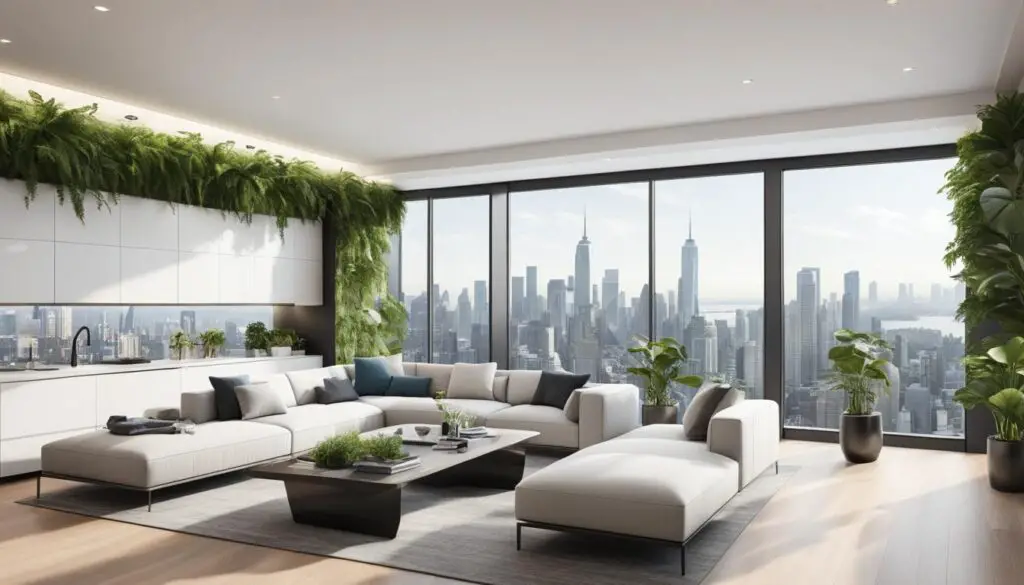
Imagine a future where architects and designers can create virtual models of urban homes with intricate detail, allowing potential buyers to explore every aspect of their future homes without leaving the comfort of their current properties. Virtual reality technology will enable realistic virtual tours, where prospective buyers can interactively navigate through an immersive digital representation of the space.
Not only will virtual reality transform the buying experience, but it will also redefine the limits of creativity in urban home design. Architects will have the ability to experiment with unconventional forms, materials, and spatial configurations, pushing the boundaries of what is possible in urban living.
Augmented Reality: Blurring the Boundaries Between Virtual and Real
As we look to the future, augmented reality (AR) has the potential to complement virtual reality in revolutionizing urban home design. AR overlays digital information and virtual objects onto the real-world environment, enabling designers to visualize and modify urban spaces within their physical context. This technology will allow architects and designers to make real-time changes to a physical space while seeing the immediate impact of their alterations. With AR, the design process will become more dynamic and interactive, fostering collaborative exploration and decision-making.
The Rise of Sustainable Technologies
In the future of urban home design, sustainability will be at the forefront. Evolving technologies will enable architects and designers to integrate eco-friendly solutions seamlessly. From solar panels to energy-efficient systems, urban homes will become powerhouses of sustainability, minimizing their carbon footprint and reducing their reliance on traditional energy sources.
3D printing technology will also play a significant role in the future of urban home design. This innovative technique allows for the creation of highly complex and customizable structures with minimal material waste. As 3D printing technology advances, the cost and time required to build urban homes will decrease, opening doors to affordable and sustainable housing options.
The Smart Home Revolution
The future of urban home design will be intertwined with the progress of smart home technologies. From smart appliances to home automation systems, technology will seamlessly integrate into every aspect of urban living. Virtual reality will enable homeowners to experience and interact with their future smart homes before construction begins, ensuring that every detail meets their preferences and lifestyle requirements.
With advancements in artificial intelligence, urban homes will become more intuitive and responsive, adapting to occupants’ needs and optimizing energy efficiency. From automated lighting and temperature control to voice-activated assistants, the smart home revolution will elevate urban living to new heights of comfort, convenience, and sustainability.
As we look forward to the future of urban home design, it is clear that evolving technologies will pave the way for a new era of innovation and possibility. Virtual reality, augmented reality, sustainable technologies, and smart home advancements will reshape the way we design, build, and experience urban homes. The future is limitless, and urban homeowners can anticipate a world where their dreams and aspirations are made a reality through the power of technology.
Conclusion
Virtual reality has revolutionized urban home design, providing residents with enhanced experiences and redefining the way homes are created. By utilizing this technology, architects and designers can redefine space, optimize layouts, and create innovative designs that cater to the needs of modern city dwellers. The virtual reality experience also enhances the home buying process, allowing potential buyers to take virtual tours and interact with realistic renderings, enabling informed decision-making.
Moreover, virtual reality enables homeowners to personalize and customize their living spaces according to their individual preferences, ensuring that urban homes reflect their unique style and needs. The technology also promotes energy efficiency and sustainability by simulating eco-friendly features and integrating green building practices into the design process.
Collaboration and communication are streamlined with virtual reality, allowing seamless workflows and effective decision-making among architects, designers, and clients. As technology continues to evolve, virtual reality is set to shape the future of urban living. Future advancements, such as augmented reality and 3D printing, will further enhance the design and construction process, creating even more immersive and efficient urban homes.
FAQ
How does virtual reality technology impact urban home design?
Virtual reality technology revolutionizes urban home design by allowing architects and designers to create immersive and efficient spaces that cater to the needs and preferences of modern city dwellers.
How does virtual reality redefine space in urban homes?
Virtual reality simulations enable architects and designers to visualize and experiment with different spatial configurations, furniture placement, and interior designs, optimizing the use of space and making urban homes more functional and visually appealing.
How does virtual reality enhance the home buying experience?
Virtual reality offers potential buyers virtual tours and interactive viewing options, allowing them to explore and experience urban homes without physically visiting the properties. They can take virtual tours, interact with virtual objects, and view realistic renderings to make informed decisions.
Can homeowners customize and personalize their urban homes with virtual reality?
Yes, virtual reality allows homeowners to virtually design and visualize their ideal living spaces, selecting furniture, finishes, and decor options that reflect their personal style. This level of customization ensures that urban homes are tailored to the unique tastes and needs of each resident.
How does virtual reality promote energy efficiency and sustainability in urban home designs?
By visualizing and simulating various energy-saving features, such as solar panels, green roofs, and smart home technologies, architects and designers can create eco-friendly and energy-efficient homes. This benefits the environment and helps homeowners reduce their energy consumption and lower utility costs.
How does virtual reality facilitate collaboration and communication in the urban home design process?
Architects, designers, and clients can use virtual reality to share ideas, make real-time changes, and provide feedback, resulting in a seamless workflow and efficient decision-making. This level of collaboration ensures that all stakeholders are involved in the design process and allows for effective communication of design concepts and goals.
What is the future of urban home design with virtual reality?
As technology continues to evolve, new tools and techniques, such as augmented reality and 3D printing, will revolutionize the way urban homes are designed, built, and experienced. Virtual reality is just the beginning of advancements that will shape the future of urban living.



